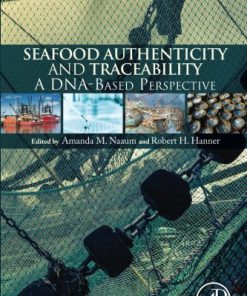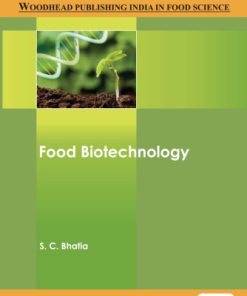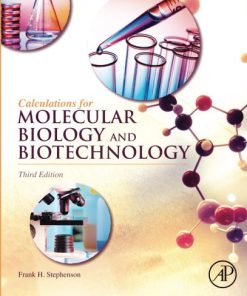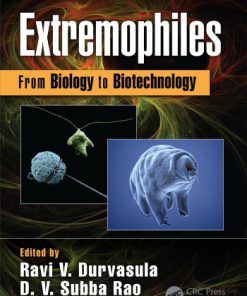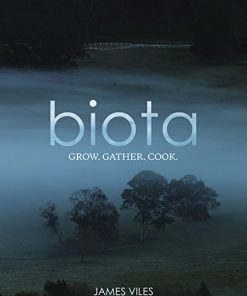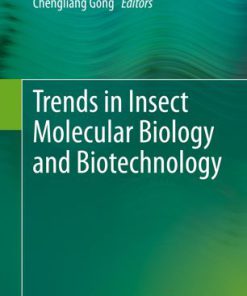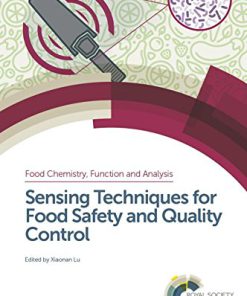Molecular techniques in food biology : safety, biotechnology, authenticity and traceability First Edition by El Sheikha 1119374618 9781119374619
$50.00 Original price was: $50.00.$25.00Current price is: $25.00.
Molecular techniques in food biology : safety, biotechnology, authenticity and traceability First Edition by El Sheikha – Ebook Instant Download/Delivery ISBN(s): 1119374618, 9781119374619

Product details:
- ISBN 10: 1119374618
- ISBN 13: 9781119374619
- Author: Sheikha
Molecular Techniques in Food Biology: Safety, Biotechnology, Authenticity & Traceability explores all aspects of microbe-food interactions, especially as they pertain to food safety. Traditional morphological, physiological, and biochemical techniques for the detection, differentiation, and identification of microorganisms have severe limitations. As an alternative, many of those responsible for monitoring food safety are turning to molecular tools for identifying foodborne microorganisms. This book reviews the latest molecular techniques for detecting, identifying, and tracing microorganisms in food, addressing both good foodborne microbes, such as those used for fermentation and in probiotics, and harmful ones responsible for foodborne illness and food quality control problems.
Table of contents:
1 How to Determine the Geographical Origin of Food by Molecular Techniques
1.1 Linkage Between Food and Its Geographical Origin: Historical View
1.2 Scope and Approach
1.3 Definitions Related to Tracking of Food Origins
1.4 Driving Forces for Determining the Geo‐origin of Food
1.5 Geo‐origin Determination … Evolution of Molecular Techniques
1.6 Pros and Cons of Molecular Techniques Used as Geo‐Discriminative Tools of Food
1.7 Conclusions
References
2 Unraveling Pathogenic Behavior of Phytopathogens through Advanced Molecular Techniques
2.1 Introduction
2.2 Plant Pathogens: A Menace to Agricultural Productivity
2.3 Future Directions
References
3 Molecular Characterization of Ochratoxigenic Fungal Flora as an Innovative Tool to Certify Coffee Origin
3.1 Introduction: Coffee Factsheet
3.2 The Microflora of Coffee
3.3 Detection of Ochratoxigenic Fungi in Coffee by Molecular Techniques
3.4 Using Molecular Detection of OTA‐producing Fungi to Certify Coffee Origin: Is it Possible?
3.5 Conclusions and Future Perspectives
References
4 Molecular and “Omics” Techniques for Studying Gut Microbiota Relevant to Food Animal Production
4.1 Introduction
4.2 Methods for Studying Gut Microbiota Composition
4.3 Culture‐independent Techniques
4.4 Tools for Functional Studies of Gut Microbiota
4.5 “Omics”
4.6 Animal Models
4.7 Bioinformatics
4.8 Application in Poultry and Swine Research
4.9 Integrated Approaches for Studying Gut Microbiome
4.10 Conclusions and Future Directions
Acknowledgments
References
5 Molecular Techniques for Making Recombinant Enzymes Used in Food Processing
5.1 Introduction
5.2 Molecular Strategies to Produce Recombinant Enzymes Used in the Food Industry
5.3 Applications and Safety Issues of Enzymes in the Food Industry
5.4 Conclusions and Future Perspectives
References
Section II: Fruits and Vegetables
6 Molecular Identification and Distribution of Yeasts in Fruits
6.1 Introduction
6.2 Molecular Methods for Distinguishing Yeast Species and Strains
6.3 Yeast Diversity in Wild/fresh Fruits
6.4 Yeast Diversity in Processed Fruits
6.5 Conclusions and Future Perspectives
Acknowledgments
References
7 Current and New Insights on Molecular Methods to Identify Microbial Growth in Fruit Juices
7.1 Introduction
7.2 Microorganisms in Fruit Juices
7.3 Conventional Identification Techniques
7.4 Non‐conventional Identification Techniques
7.5 Molecular Techniques
7.6 Conclusions and Future Perspectives
References
Section III: Fish and Meat Products (Non‐Fermented)
8 Molecular Techniques Related to the Identification of the Bacterial Flora of Seafood
8.1 Introduction
8.2 Major Seafood Spoilage Bacteria
8.3 Seafood‐borne Bacterial Pathogens
8.4 Conclusions and Future Perspectives
References
9 Assessment of the Microbial Ecology of Meat and Meat Products at the Molecular Level: Current Status and Future Perspectives
9.1 Introduction
9.2 Extraction of Nucleic Acids
9.3 Microbial Communities Assessment
9.4 Detection of Selected Bacterial Target
9.5 Biodiversity Assessment
9.6 Conclusion and Future Perspectives
References
Section IV: Fermented Foods and Beverages
10 Revolution in Fermented Foods
10.1 Introduction
10.2 Historical View: Where and When Did Fermentation Start?
10.3 Fermented Foods: From the Past to the Current Era
10.4 Fermented Foods and Health Effects
10.5 Is it Possible to Trace the Geographical Origin of Fermented Foods?
10.6 Conclusions and Future Perspectives
References
11 Molecular Techniques for the Identification of LAB in Fermented Cereal and Meat Products
11.1 Introduction
11.2 Fermented Food Products
11.3 Lactic Acid Bacteria and Fermented Foods
11.4 Molecular Approaches Used to Study Fermenting Microflora
11.5 Identification of Lab in Fermented Cereal and Meat Products
11.6 Advantages of Molecular Techniques
11.7 Concluding Remarks
Acknowledgment
References
12 Molecular Techniques and Lactic Acid‐Fermented Fruits and Vegetables
12.1 Introduction
12.2 Fermented Fruits and Vegetables: Between the Past and the Present
12.3 Benefits of Fermented Fruits and Vegetables
12.4 Techniques of Lab Analysis Used in Fermented Fruits and Vegetables
12.5 Future Applications
12.6 Conclusions
References
13 New Trends in Molecular Techniques to Identify Microorganisms in Dairy Products
13.1 Introduction
13.2 Polymerase Chain Reaction (PCR)‐based Methods
13.3 Fluorescent In Situ Hybridization
13.4 Immuno‐based Methodologies, Biochips, and Nanosensors
13.5 Benefits and Limitations of Molecular Techniques
13.6 Conclusions and Future Perspectives
References
14 Molecular Techniques for the Detection and Identification of Yeasts in Wine
14.1 Introduction
14.2 Methods of Identification and Detection of Biodiversity
14.3 Enumeration of Wine Yeasts
14.4 Diversity of Wine Yeasts
14.5 Conclusions and Future Perspectives
References
Section V: Foodborne Pathogens and Food Safety
15 Rapid Detection of Food Pathogens Using Molecular Methods
15.1 Introduction
15.2 Methods Used to Detect Foodborne Pathogens
15.3 Conclusions
References
16 Biosensor‐Based Techniques
16.1 Introduction
16.2 Ideal Requirements for Biosensor‐based Microbial Detection Assay
16.3 Need for Rapid Method
16.4 Classification of Biosensors
16.5 Conclusions and Future Perspectives
References
17 Molecular Identification and Detection of Foodborne and Feedborne Mycotoxigenic Fungi
17.1 Mycotoxigenic Fungi
17.2 Polymerase Chain Reaction‐based Characterization of Mycotoxigenic Fungi
17.3 Genomics of Mycotoxigenic Fungi
17.4 Functional Genomics of Mycotoxigenic Fungi
17.5 Conclusions and Future Perspectives
References
18 Molecular Identification of Enteric Viruses in Fresh Produce
18.1 Introduction
18.2 Sample Treatment
18.3 Sample Receipt
18.4 Removal of Viruses from the Food Surfaces
18.5 Removal of Food Substances
18.6 Concentration of Viruses
18.7 Nucleic Acid Extraction
18.8 Detection Assay
18.9 ISO 15216‐1/2:2013: The Future “Gold Standard”
18.10 Quantitation
18.11 What is a Positive?
18.12 Future Developments and Requirements
18.13 Conclusions and Future Perspectives
References
Section VI: Future Perspectives
19 Molecular Techniques and Foodstuffs: Innovative Fingerprints, Then What?
19.1 Introduction
19.2 Emerging Fingerprinting Technologies
19.3 DNA Fingerprints
19.4 Conclusions and Future Perspectives
People also search:
molecular gastronomy techniques
molecular gastronomy food recipes
molecular food recipes
molecular gastronomy food examples
molecular food science
You may also like…
Technique - Food Manufacturing
Biology and other natural sciences - Biotechnology
Calculations for Molecular Biology and Biotechnology 3rd Edition Frank H. Stephenson
Science (General)
Extremophiles From Biology to Biotechnology First Edition Durvasula
Computers - Computer Science
Cookbooks
Biology and other natural sciences - Biotechnology
Trends in Insect Molecular Biology and Biotechnology Dhiraj Kumar
Science (General)
Sensing Techniques for Food Safety and Quality Control Xiaonan Lu 178801197X 9781788011976




